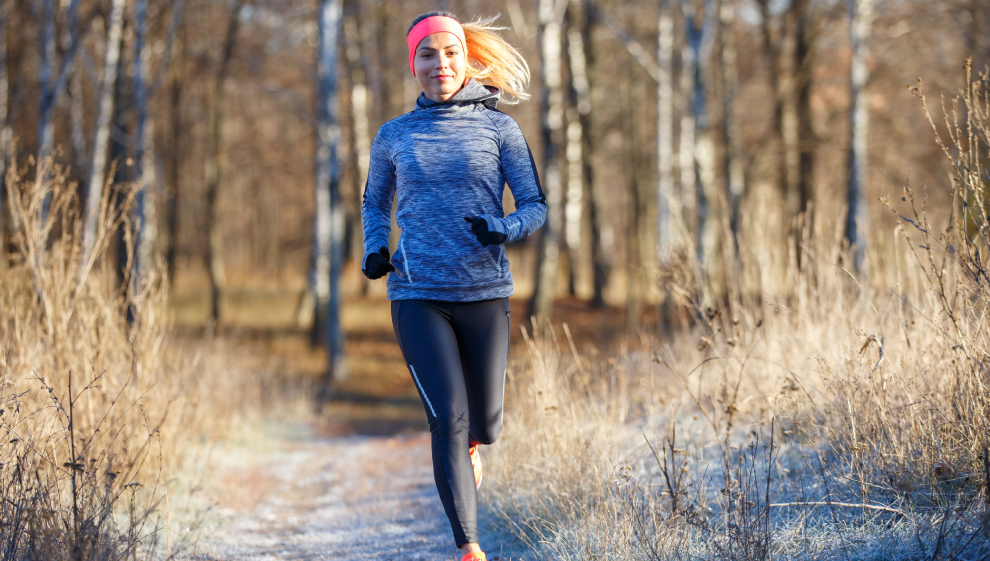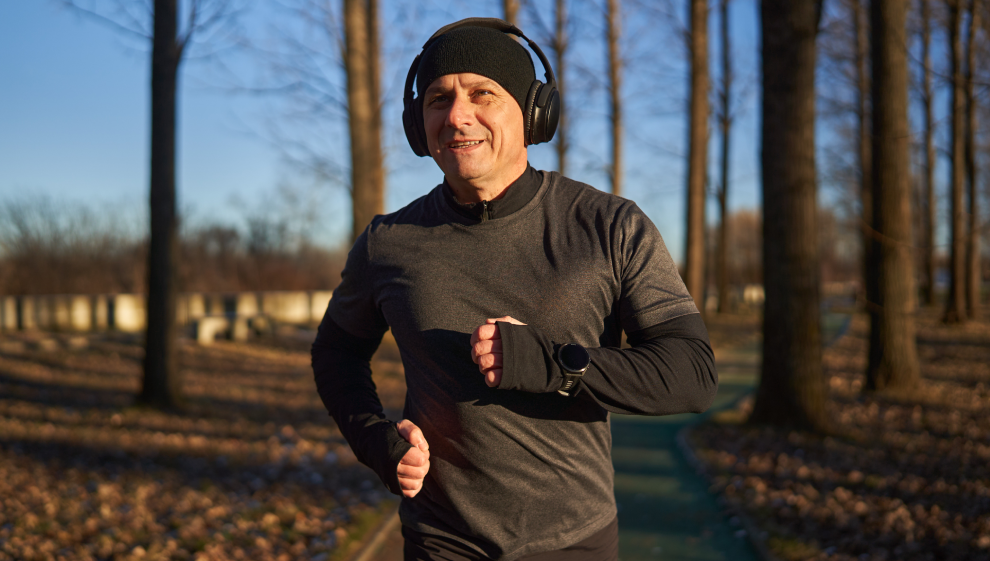Expert tips for running in winter
Key takeaways
- Tread heavy and go slow – you’re more likely to slip and fall in winter
- Prioritise comfort and wear clothes that are comfortable
- Choose moisture wicking clothes made from breathable fabrics
- Stay safe and seen with high-visibility gear where possible
- Avoid heavy garments like hoodies, sweatshirts, and joggers
- Don’t “over layer” – you’ll soon warm up once you get moving
- See a GP if you have a respiratory condition before exercising in freezing cold temperatures
- Know when to say no and exercise indoors or at the gym
How to adapt in winter
It’s no secret that exercising outdoors in the UK can be difficult.
Depending on where you are in the country, expect short and dark days, freezing cold temperatures, rain, sleet and even some snow. If this doesn’t sound like your cup of tea, you’re not alone.
If you are looking to keep up or kickstart your training during winter, you need to know how to keep yourself and others safe.
Be prepared to run in the dark
Making sure you’re always visible is the name of the game when running in the dark.
Whether you’re pounding the pavement in your local area or running paths and trails in the dark, you need to know what and who is around you.
Making yourself seen means wearing clothes and accessories that reflect or generate light. Popular options include high-visibility jackets and torch-lit hats. You can also buy thin reflective strips that loosely wrap around your ankles or wrists to alert motorists, cyclists, and pedestrians.
In the dark, you need to be more aware of your own surroundings than usual. Avoid areas that are dimly lit and lay off the trails when running at night. Not only can tree roots and level changes be hard to spot, but if you do have a fall and injure yourself, getting help at night can be difficult.
Stay safe if it snows

If it’s snowing, it’s probably best to lay off running until it’s cleared. In the UK, it’s never more than a few days before snow has cleared and the pavements are dry again.
If you live in a country where it snows regularly, or you feel like running in the snow, tread with a heavy step and avoid slick ice underfoot. Get your heavier trail shoes out (they tend to have better traction and a thicker tread) and consider wearing waterproof trousers. The slush and slurry you throw up underfoot will soak long-leg joggers and garments made from non-waterproof material.
Make sure to shorten your stride, plant your feet, and take it slow. Never prioritise speed over safety, especially in adverse conditions. Listen to your body and never take risks. If you set out and it doesn’t feel safe, turn around and stay indoors.
Learn to run in the rain
A lot of the same rules apply when it’s raining. Wear gear that’s waterproof to prevent chaffing and discomfort, and opt for shoes with increased grip.
You aren’t going to put up any competitive times when it’s raining, so take it slow and focus on maintaining a nice, comfortable pace. You can get back to your intervals and speed workouts when the weather clears up.
When running in the rain, make sure to protect any electronics you might have on you. Many a phone has been lost running in the rain. This goes for smartwatches and headphones too. If you’re a serious runner, investing in waterproof options or cases for your gadgets will save you spending on replacements in the long run.
A lot of runners like to use anti-chafe creams when it’s raining. This is because once you’re wet, your clothes can start to rub and chafe against your skin. These creams typically contain lubricating agents like petroleum jelly or silicone which form a protective barrier, preventing irritation and chafing.
What to wear
Hat or no hat?
Wearing a woolly hat might make you feel warm and snug when you step out into the cold, but wearing one on a run can quickly result in increased sweating and overheating.
Runners tend to warm up within 5 to 10 minutes once the blood gets pumping, so we recommend leaving the hats at home. If you do want to wear one to cover your head and ears, opt for something lightweight and breathable.
Consider hats with an outer layer made of windproof, water-resistant materials to shield you from the elements, especially in harsh winter conditions.
Snoods and neck warmers
Rashes and blotching on the neck are common during winter, as the cold, harsh air can irritate sensitive skin, especially when exercising.
Snoods are a versatile garment (much like a lightweight neck warmer or scarf) that wraps loosely around the neck to guard against the cold, wind, and rain.
Many snoods are made from moisture-wicking materials like polyester and similar blends with synthetic fibres. These materials draw moisture away from your skin, preventing sweat from accumulating and keeping your neck dry during your run.
Snoods are great when temperatures really drop, however you might want to keep yours in the bag until it gets really cold, as you will warm up quickly when you get moving. Many runners find they overload on cold weather protection and overheat when they get into stride and warm up.
Embrace base layers
Base layers are essential for cold-weather exercise.
They efficiently manage sweating, insulate your skin against the cold, and help you maintain a comfortable body temperature whilst you run.
Made from moisture-wicking materials like synthetic fabrics or merino wool, base layers pull sweat away from the body, preventing it from lingering on our skin and causing discomfort. These synthetic materials and merino wool are renowned for their insulating properties, even when damp, making them perfect for use during winter.
Base layers are also great for keeping us warm. Close fitting to provide insulation, they trap a thin layer of air close to the body. This pocket acts as a thermal barrier that keeps heat close to the body. On top of this, base layers promote breathability which means excess heat can escape during intense exercise. This prevents overheating and body temperature regulation.
Waterproof jackets and top layers
Nobody likes getting wet on a run. You’ll feel uncomfortable and run the risk of chaffing before long.
No matter what you’re wearing, topping it off with a waterproof jacket if there’s the threat of rain will do you the world of good. Running jackets are made with a water-repellent outer layer that encourages rainwater and moisture to run off the fabric.
They’re also lightweight and breathable, meaning you won’t overheat or feel constricted when moving your upper body.
If jackets aren’t your thing, all the top running brands do some form of long sleeve base layer that can double as a waterproof top layer.
- Want to layer the right way? Click here for expert advice
Don’t underestimate a good pair of socks
Running socks are more important than ever in winter.
Unlike regular cotton socks, running socks are typically made using a moisture-wicking material like merino wool. These fabrics do the same job your running tops do. They pull the sweat your body generates away from your skin, keeping your feet dry which reduces the risk of developing blisters and fungal infections.
Wearing your everyday socks during winter runs can lead to moisture retention which is something you don’t want. Ideally, moisture is allowed to exit and evaporate away from the body without becoming trapped on the skin.
Investing in proper running socks accelerates this moisture management system. You’ll also feel warmer and more comfortable for longer, both of which contribute to a more enjoyable and injury-free running experience.
Running socks also provide insulation which is crucial in cold weather. If you ever find your feet going numb on a long run, chances are you need better, more insulative socks. A lot of the running socks produced today even feature extra padding for comfort and protection against impact.
Whilst they’re great for keeping the heat in, they’re also breathable. This means they prevent your feet going the other way and overheating.
Getting the right pair of shoes
When shopping for running shoes, consider budget, where you’ll be running and how much use they’ll get. If you’re shopping for a specific pair of shoes for winter use, consider the following:
- Trail shoes: are you going to be running on wet and muddy trails? Trail running shoes are typically heavier and are designed for off-road terrain. They have more traction, durability, and provide better protection against uneven surfaces
- Waterproofing: if you want a pair of shoes to wear when it’s raining, consider options that include a waterproof membrane
- Traction: traction in winter is really important. Evaluate the thickness and durability of the tread pattern underneath your shoe if you’re concerned about a lack of grip
- Style: this all comes down to personal preference. Don’t struggle with a pair of uncomfortable shoes that you’re unfamiliar with just because they’re sold as being “good for winter runs”
- Cleaning: you’ll find yourself doing a lot of this. Let your shoes dry first, then brush off any excess dirt. Use a damp cloth for stains and avoid using a washing machine as it can damage the shoe and affect performance. Remove the insoles and wash them separately whilst air-drying your shoes thoroughly.
Should I slow down?
You can still do speed work like fartlek sessions, track work, hill sprints and intervals in winter, but just be wary of the state of the surface you’re running on.
Joining a local club and making use of their track facilities can be helpful in winter. Tracks are clearly lit and marked, meaning you can run faster without worrying about slips, trips, and falls.
Are injuries more common?
Winter and cold temperatures introduce several factors that may increase your risk of injury. These include:
- Colder muscles
- Decreased muscle and tendon elasticity
- Stiffer joints
- Slippery conditions underfoot
- Perceived lack of dehydration risk due to lack of heat
- Poor visibility
- Respiratory issues
- Aggravated skin
- Blisters and chafing in wet conditions
Whilst there is no definitive data suggesting that more injuries occur in the winter, the conditions and environments we exercise in during these months can increase the risk of falls, sickness, and joint pain.
In the dark, our vision is impaired and our reaction times are slower, making us more susceptible to trips, slips, and falls whilst running. The wet and slippery pavements and paths that we don’t have to think about in summer also become an ever-present threat underfoot.
We should also consider mental health conditions like seasonal affective disorder (SAD)when thinking about winter exercise. Many people experience negative fluctuations in their mental health during winter, which can make getting the “feel good factor” from exercise more difficult.
Taking care of your skin
An often under looked element of training outdoors during winter that affects a lot of runners is skin health.
Cold weather and dry air can lead to skin dehydration and irritation. Exposing the skin to chilly winds during outdoor runs can strip away natural oils, causing dryness, chapping, and redness.
Extended exposure to winter sun can contribute to sunburn. It’s vital we remember that just because it’s cold, doesn’t mean you can’t get sunburnt and dehydrated. To safeguard skin health, it's essential to moisturise before and after workouts, ideally using products with protective ingredients like SPF.
Additionally, choosing appropriate clothing made from moisture-wicking and breathable fabrics will help regulate the temperature of our skin and lessen the impact of chaffing and irritation.
Overall, a holistic approach to skincare that includes adequate hydration, moisturising, and sun protection will help ensure healthier and more comfortable outdoor exercise experience during the winter.
Changing how you breathe

Ever felt a tight, burning sensation in your chest or throat when running in the cold?
This happens when cold, dry air hits our throat and lungs without being heated. Cold air can irritate and dry out the mucous membranes in our respiratory tract, leading to a raw sensation that only gets worse when our body instinctively constricts our airways as a response.
Wearing a scarf, snood, or mask over your mouth and nose to partially warm and humidify the air you’re breathing in can help with this. Keeping hydrated is also important, as dehydration can make the irritation in your throat worse.
If you feel a persistent shortness of breath or you’re finding it hard to breathe on a run, cease exercise immediately and seek help. If symptoms worsen over time, consult a professional, especially if you have an underlying respiratory condition like asthma.
How cold is too cold?
Fortunately, proper layering and getting warm before you go outside generally make exercising outdoors safe for most people in temperatures as low as -20 degrees Celsius.
What’s safe and what feels comfortable will vary from person to person. If you’re wondering whether exercising during winter is safe for you, speak with your GP about any concerns you have.
When to stay in doors
In the UK, the air and wind temperature will rarely get low enough to make exercise unsafe. This may not be the case if you have a health condition, or you are more susceptible to cold temperatures.
Certain individuals should consider the legitimate threat of frostbite and windchill. For example, if you have asthma, a respiratory condition, or if you have an increased risk of hypothermia, we recommend avoiding exercise in freezing temperatures.
Managing injuries during winter
Injuries are a frustrating part of the running process. Whether you’re nursing a bruised knee after a fall or you’ve felt something in your ankle, getting yourself checked out is really important. The more you run through an injury, the higher the risk of reinjury.
Getting checked over by a physio can help put your mind at ease and get you back on the road quickly.
How gait analysis can help
Whether you’re a new or experienced runner, there’s a lot you can do to maximise performance out there.
Gait analysis is the examination of your walking or running pattern. This helps assess biomechanics, identify any irregularities, and determine the most suitable footwear for you.
The goal is to optimise performance, prevent injuries, and enhance overall comfort. A gait analysis typically involves the observation and analysis of your:
- Stride length
- Cadence
- Arch profile (low, medium, or high)
- Heel strike
- Midfoot strike
- Forefoot strike
- Pronation pattern (whether your foot slopes inwards when you step)
Gait analysis is designed to help you get the right shoes for your feet to avoid injury, slips, and falls. You can get one done at most local running shops, where you can also ask any questions you might have about running more generally.
Free expert running plans
At Nuffield Health, we give you free access to a range of running plans put together by our team of experts. Whether it’s a 5k or marathon you’ve got your eyes on, we can help.
Click any of the links below to get started:
Last updated Tuesday 8 October 2024
First published on Tuesday 8 October 2024

